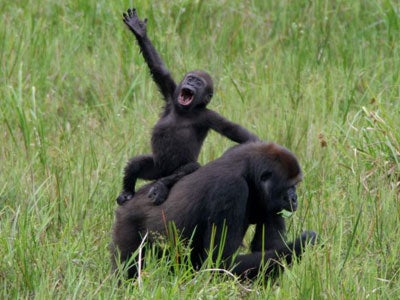Primates 'at risk of extinction'

Nearly half of all the species of monkeys and apes in the world are in danger of extinction with primates as a whole representing one of the most threatened group of mammals today, a study has found.
The latest assessment of man’s closest living relatives has found that 48 per cent of the 634 different kinds of primates could soon die out completely due to factors such as habitat loss and hunting.
Scientists who carried out the study for the International Union for the Conservation of Nature (IUCN) believe that the situation has worsened significantly since the last time a similar investigation of primates was done five years ago.
In some parts of the world the threat to primates has reached crisis proportions. In Vietnam and Cambodia, for instance, about nine out of every 10 species are now listed as either vulnerable, endangered or critically endangered – the three most threatened classifications on the IUCN’s Red List of Threatened Species.
“What is happening in south-east Asia is terrifying. To have a group of animals under such a high level of threat is, quite frankly, unlike anything we have recorded among any other group of species to date,” said Jean-Christophe Vie, deputy head of the IUCN’s species programme.
The review was carried out by hundreds of primatologists who assessed factors such as the loss of habitat, total population size or pressures from hunting which could affect a species chances of survival in the coming century.
“We’ve raised concerns for years about primates being in peril, but now we have solid data to show the situation is far more severe than we imagined,” said Russ Mittermeier, president of Conservation International, and a primate specialist on the IUCN’s Species Survival Commission.
“Tropical forest destruction has always been the main cause, but now it appears that hunting is just as serious a threat in some areas, even where the habitat is still intact. In many places, primates are quite literally being eaten to extinction,” Dr Mittermeier said.
Primates include species as small as the tiny mouse lemurs of Madagascar, which can fit inside a teacup, to the large lowland gorilla of western Africa. They also include man’s closest living relative, the chimpanzee, which shares about 98 per cent of its DNA with humans.
Dr Mittermeier said that one in every three primate species is now either endangered or critically endangered compared to about one in five primates classified in these two risk categories before the results of this latest assessment emerged.
“The pressures on them have increased with the big push towards growing monoculture crops, in part for their use as biofuels. The growing of palm oil crops in south-east Asia and soya beans in the Amazon have taken their toll,” Dr Mittermeier said.
“But hunting of primates for bushmeat has also increased. This was a subsistence issue but now it’s almost become a luxury food with a higher price than for chicken or fish, both in African and in south-east Asia,” he said.
Among the most threatened primate species were two of the red colobus monkeys – Bouvier’s red colobus and Miss Waldron’s red colobus, neither of which has been seen by primatologists for the past quarter of a century.
Despite the threats to primates, scientists have since 2000 described 53 new primate species that are new to science, including 40 species from Madagascar. In 2007, researchers discovered a population of greater bamboo lemurs living a wetland site on the island, about 240 miles from the only other known population of the species – bringing the total number of individuals living in the wild to about 140.
The latest report, however, says that there have been success stories, notably the black lion tamarin and the gold lion tamarin of Brazil’s decimated Atlantic Forest, which have been brought back from the edge of extinction, being classified as endangered rather than critically endangered.
Anthony Rylands of the IUCN’s Primate Specialist Group, said: “If you have forests, you can save primates. The work with lion tamarins shows that conserving forest fragments and reforesting to create corridors that connect them is not only vital for primates, but offers the multiple benefits of maintaining healthy ecosystems and water supplies while reducing greenhouse gases emissions that cause climate change.”
Join our commenting forum
Join thought-provoking conversations, follow other Independent readers and see their replies
Comments
Bookmark popover
Removed from bookmarks